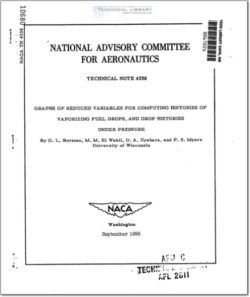NACA-TN-4338

- Version
- 171 Downloads
- 1.72 MB File Size
- 1 File Count
- December 4, 2015 Create Date
- December 4, 2015 Last Updated
National Advisory Committee for Aeronautics, Technical Notes - Graphs of Reduced Variables for Computing Histories of Vaporizing Fuel Drops, and Drop Histories Under Pressure

The purpose of the present investigation was two-fold. The first
objective was to obtain a simplified calculation technique that would
replace the complicated automatic canputer calculations. The second.
objective was to obtain emerimental data for single droplets vaporizing
at pressures greater than 1 atmosphere and to check computed histories
against these data.
A method of calculation using reduced curves and nomograms is ex-
plained. Graphs and nomograms that can be used to calculate histories
of n—decane droplets are presented. Similar graphs may be constructed
for any pure fuel with known physical properties, as described in this
report. The accuracy of the calculation technique is shown to be within
the agreement between eweriment and theory. The method of application
of such simplified calculations to fuel sprays is discussed, and. the
limitations of the calculations are pointed. out.
Steady-state temperatures of hexane, decane, and hexadecane were
obtained experimentally for various temperatures and pressures from 1 to
5 atmospheres. The experimental data agreed with the calculated values
to within 3:100 R. A few emerimental unsteady-state histories for _r_L-
decane at 2 and 4 atmospheres pressure are presented. These histories
show no great deviation from the calculated histories.
An understanding of the processes that occur in the atomization,
acceleration, and. vaporization of fuel droplets in a spray is important
to the design of combustors. Atomization results in breaking the mass of
the liquid fuel into a spray of tiny spherical droplets and thus tremen-
dously increases the fuel surface area exposed to the air. The total
mass vaporized from the spray may then be obtained from a study of the
vaporization of each droplet, or a number of individual droplets, in the
spray.
Earlier investigations‘at the University of Wisconsin were concerned
with the problem of predicting the temperature and mass histories of
single droplets. A theoretical investigation (ref. 1) showed the effects
of the unsteadyhstate portion of the vaporization histories to be of con-
siderable importance. The theoretical study was followed by an experi—
mental study (refs. 2 and 5) primarily concerned with vaporization under
atmospheric pressure. Liquid-fuel droplets were hung on a spherically
shaped thermocouple Junction. Heated air was then suddenly caused to
flow over the drop.
| File | Action |
|---|---|
| naca-tn-4338.pdf | Download |

Comment On This Post